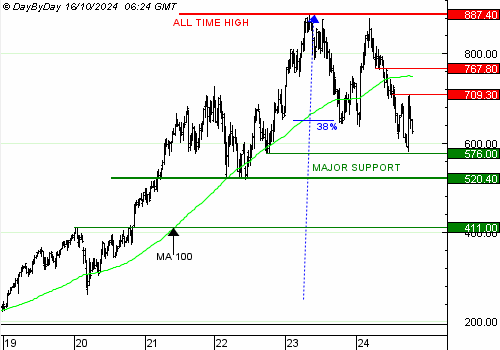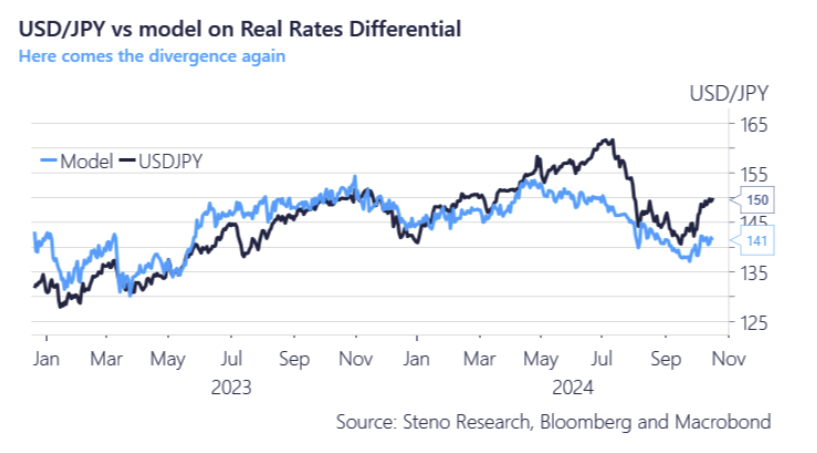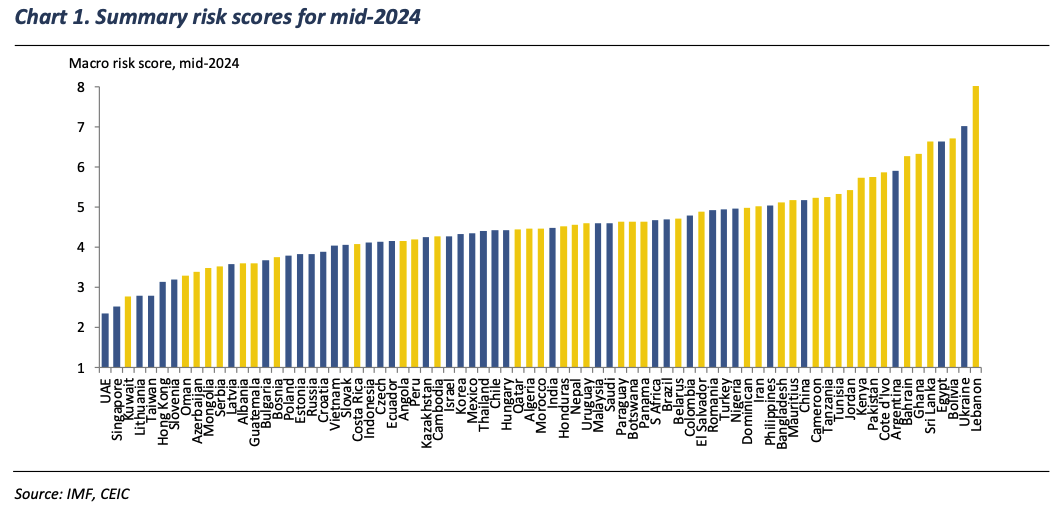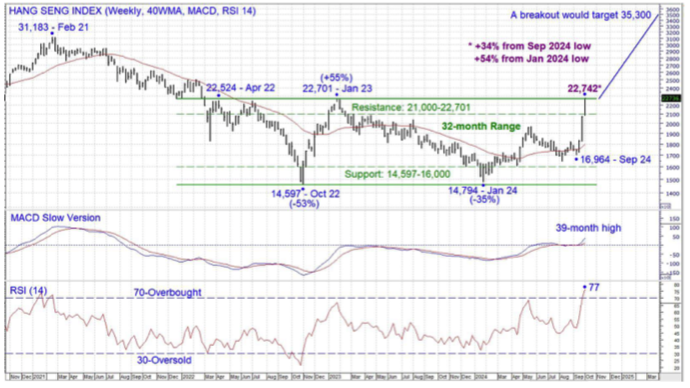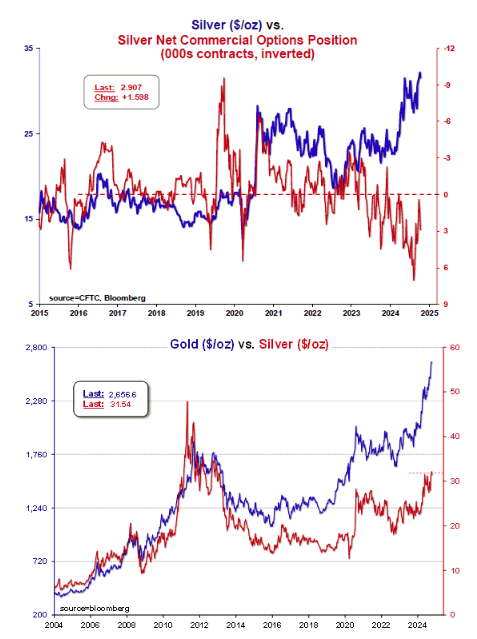Fortnightly Publication Highlighting Latest Insights From IRF Providers
Company Research
Geography
Europe
European stocks fell earlier this week as ASML’s guidance cut was compounded by disappointing sales at LVMH. Recent share price action at LVMH (see chart) has resulted in the medium-term trend switching to neutral, but not bearish, meaning buying weakness is still a reasonable strategy. €520/€500 is the level investors should expect to be tested in the near term. Meanwhile, ASML is playing around its major support, the 38% Fibo of the rally since 2020. It had briefly been broken a few weeks ago, hence this new test has a very low probability of re-establishing a rise. Buying will not be an option for a while.
UK tax raid rumours create a buying opportunity - FLTR will be able to weather the impacts through market share gains and cost containment measures. Hedgeye sees the blended tax rate going to ~35% starting next year. The market size will be lower as will the profit pool, but FLTR’s piece of the pie will be bigger in the long term. Anyway, it is not the UK growth story that matters (it will represent <20% of EBITDA by 2026 and well below 20% on a long-term basis) as Hedgeye makes the case that the group’s US business alone is worth nearly $200 / share. On revised figures out to 2027, they see a $300+ stock.
Mercedes-Benz (MBG GR) Germany
The German car manufacturer is outperforming rivals, according to Woozle’s latest channel checks - MBG dealerships reported average revenue growth +3.1% Y/Y in Q3. Strong performance was noted In the Americas with a +4.5% Y/Y revenue increase, while Asia reported +2.5% growth and Europe +2.4% increase. Sales volumes increased by an average of +2.5% across all regions. This momentum has been fuelled by competitive financing options and a strong sales mix. However, demand for EVs remains challenging, with decreased sales reported in the Americas, while Europe and Asia showed stable but restrained interest.
Alfen (ALFEN NA) Netherlands
Strategy update and near-term outlook unlikely to inspire investors - the IDEA! would rather have seen ALFEN focus on its EV Charging Equipment and Smart Grid Solutions and to divest its Energy Storage Systems division, arguing this activity is too volatile, strongly impacting on the predictability of earnings. Based on the company’s FY25 outlook projection and assuming an EBITDA margin of 8%, ALFEN targets an EBITDA of roughly EUR 42.5m. Assuming net debt of approx. EUR 90m, the company’s EV amounts to EUR 375m, implying a valuation multiple of close to 9 times. FCF will be limited. Working capital management will be the key to debt reduction.
Infrastructure stocks offer huge upside
The companies covered by Insight offer an average upside of 90%. Their top 3 names are: 1) Ferrovial (TP €82) - US Managed Lanes EBITDA growing rapidly on good transactions growth and excellent toll increases. 2) Canadian National Railway (TP C$354) - mostly unregulated pricing and limited cyclicality of EBITDA. Strong recurring FCF growth, High ROIC and shareholder remuneration to grow at >6% CAGR to 2050E. 3) Cellnex (TP €75) - pan European tower platform with strong market positions and inflation linked contracts. Paused acquisition strategy will see rapid deleverage, stronger grade credit rating, then enhanced shareholder remuneration.
ASML (ASML NA) Netherlands
The combination of economic-related delays and China realising that stockpiling ASML equipment ahead of further bans might not help them very much has caused the company to lower its outlook for 2025 resulting in a large correction. Furthermore, while AI demand currently shows no sign of abating, when the AI correction comes, as it inevitably will, this will set back expectations further. The net result is a stock that is on 25x 2025 PER and has a question mark over its medium-term growth profile. Semiconductor companies that do the manufacturing tend to be cyclical and at this valuation Richard Windsor is still not a buyer.
North America
Earnings Q&A evasion analysis
Paragon’s latest offering on their ManagementTrack platform highlights evasive answers near real-time during earnings seasons. Their model can also flag abnormally high evasiveness % and if past instances have led to underperformance. Recent examples include 1) Lamb Weston - management's evasiveness increased significantly to 60% from 25% and 33% the prior 2 quarters. 2) McCormick - evasiveness increased to 36% from sub-10% the prior 2 quarters. 3) Disney - last quarter executives answered 78% of questions evasively. 4) Click here to access a report Paragon created overlaying their earnings call analysis with a recent note a short seller published on Roblox.
If Trump wins, how will Musk affect Telecom policy?
Analysts at New Street outline the most underappreciated telecom policy consequences of the election: the impact Elon Musk will have, if Trump is elected. They focus on 3 policies: 1) BEAD - Musk will seek to divert dollars from fibre deployments to subsidising Starlink service. 2) USF - he will attempt to see the scale of the USF programme cut back materially. 3) Spectrum (where Musk has the most to gain) - he will push for a variety of decisions in his favour, including Starlink gaining access to 2GHz spectrum currently used by Dish and Globalstar. While he will not win all these, he is likely to win some, and much more likely to win than the market appreciates.
There is no bone for this dog - Scott Mushkin initiates coverage with a Sell rating and TP of $0! He forecasts EBITDA to decline to $217m in 2026 (vs. $401m in 2023) with margins expected to come under pressure in large part due to R5’s research that competition in the industry has increased meaningfully over the last few months. Indeed, their pricing surveys show that both Amazon and PetSmart are aggressively reducing prices. At the same time, macroeconomic headwinds will also hinder sales growth. All told, and considering the company’s substantial debt load (total debt/LTM EBITDA at ~4.7x at the end of 2Q), Scott sees no equity value.
The stock trades at too high of a multiple given the collapsing revenue growth rate, according to Tom Chanos. Street estimates of 34% revenue growth this quarter and 21% growth next quarter are unrealistic. The consumer has hit the wall. Meanwhile, operating expenses are increasing rapidly. Last quarter, expenses increased 96% vs. 50% for revenue. ELF has also announced a $500m buyback plan, however, its cash flow is ~$60m p.a. and the business only has $109m cash. So, this announcement was purely to keep the stock price up. Finally, Tom flags substantial insider sales over recent months. If ELF gets a market multiple like Ulta, it is a $40 stock (60% downside).
Pipe to nowhere - Hamed Khorsand believes SOC will be unable to gain all the regulatory approvals necessary to restart the Santa Ynez Unit it acquired from Exxon. SOC is likely to spend much of the cash it has raised and end up giving back the assets to XOM without any compensation, per the purchase agreement. The share price has risen nearly 100% in the past year, but trades with no risk applied to possibilities of delays to the company’s stated timeline to restart Santa Ynez in 4Q24. TP $6 (70%).
After earnings beats from JPMorgan, Wells Fargo, Goldman Sachs, Bank of America, PNC as well as Citi why were all the other banks up significantly and Citi was down 5%? Charles Peabody discusses asset caps (Citi is already shrinking itself by shedding its global consumer bank, so an asset cap makes no sense whatsoever) and a probable delay in the Banamex IPO. He argues Citi is one of the best stories in large cap financials and is the only company able to repurchase large amounts of its common stock at a substantial discount to TBV. Expectations are low, the regulatory pressure is high and management is doing all the right things.
ILMN was pitched as a long idea at one of MYST’s recent Buy side events - the Presenter has followed the stock for quite some time and has maintained a cautious view until recently. He sees top line growth accelerating from “flattish” in FY25 to +MSD% in FY26 and +HSD-to-LDD% in FY27 as ILMN transitions from old to new generation products. He thinks competition from Ultima Genomics and Element Biosciences is vastly overstated and envisions operating margins returning to 30%+. Applying a 35x multiple to his FY27 EPS estimate of ~$8.00 (vs. $5.79 consensus) he arrives at a 2-year TP of $280 (~100% upside).
DGII has hit a wall in its attempts to transition from a product-reliant company to a subscription-based one. Revenue has started to decline, even with evidence of aggressive revenue recognition (surge in DSO, excess inventory at customer locations) and potentially aggressive accounting (inventory transferred to PP&E, recent SEC comment letters). While the shares screen as cheap, Corto believes there is 50%+ downside here with peers trading at revenue multiples closer to 1.0x vs. the company's current 2.8x multiple. The shares have rallied 30% over the last three months, in spite of horrible guidance revisions.
What multiple should a ~20% EBITDA growth business trade on? Abacus argues it should be significantly higher than 12x EV/EBITDA (2025) and expects the multiple to expand when FOUR better explains its organic growth and the sustainability of its acquisition strategy. They believe the company has an opportunity large enough to grow gross profit at a 20-30% CAGR over the coming years, split evenly between organic and M&A, where FOUR can acquire at 4x EBITDA post synergies. Near term earnings misses, due to softer macro and slower customer acquisition in Europe, provides an attractive opportunity. TP $164 (75% upside).
IT Spending: Sentiment weaker than last quarter
SPR’s latest channel checks reveal disappointment that the second half pick up that many expected has not materialised. Stock specific feedback includes: ServiceNow - all very positive - probably the strongest indications for any vendor. Crowdstrike channels and end users see the vendor moving quickly past its recent crash. SPR has picked up mixed feedback re. Fortinet’s recent security breach and whether it negatively impacted Sept Qtr end deal flow. Outside of security, the vendors seeing an increase in positive comments include IBM, Oracle, Microsoft, Arista and Juniper/Mist. It has been easy to pick up comments on share loss by Cisco.
Japan
Large cap growth screen
The point of Willis Welby’s Japan screen is not just to find stocks with growth that will compound value, but to find them at reasonable prices. They begin the process with 175 stocks with market caps north of USD 5bn. 71 have consensus Y3 revenue growth in excess of 5%. And of those, 46 pass Willis’ financial productivity and sector parameters. When they add the parameters of reasonable financial productivity and an implied to Y3 EBITM ratio of less than 110, they end up with 23 names. Focus stocks this month include Ebara, M3 and Hoshizaki.
Emerging Markets
Old e-commerce names are the biggest winners of new stimulus in China
Blue Lotus expects there will be a string of good retail data in the near-term, driven by an early start to the Double 11 sales festival, increasing consumer participation for home appliances amid the trade-in subsidy, and generally improved consumer confidence following the recent market rally and stimulus announcements. As a result, they have revised their estimates, raising 4Q24 online retail sales growth to +10.1% Y/Y (vs. prior +4.9%) and for 2025 to +9.5% (vs. prior +4.5%). A reversal of the “consumption downgrade” primarily benefits platforms with large exposure to brand and higher-end items. JD.com and Alibaba remain Blue Lotus’ top picks.
Despite EAST's huge 3-month performance (the share price has risen nearly 50%), AlphaMena maintains a bullish view, underpinned by the 47% upside offered by their DCF model. Recent numbers were robust as results were supported by strong revenue growth coupled with efficient cost-control measures (net revenues increased by 15% while PAT soared 20%). The stock is trading at low multiples (6.23x EV/EBITDA and 8.16x PE in 2025E), while offering a 13.9% dividend yield. Moreover, Philip Morris International’s recent acquisition of a minority indirect stake (14.7%) in the company is further reassuring the market about its mid-term outlook.
India’s emerging nuclear opportunity
Nuclear power currently contributes <2% of India's total electricity generation. With substantial budgetary allocation and the government's strong focus on execution and private partnerships, the country’s nuclear ambitions align well with its goal to foster clean energy. Iii’s channel checks suggest that several roadblocks present earlier are now being cleared and execution is moving in the right direction. To ride this theme, they focus on the Pumps Industry, a critical player in both traditional and renewable energy sectors. Opportunities span conventional power, solar water pumps, firefighting pumps for data centres, green hydrogen and reactor coolant pumps for nuclear plants. In this report, Iii delves deep into 3 companies with a strong presence in the industry: KSB, Kirloskar Brothers and Yuken India.
Global Chemicals: PVC - some green shoots emerging?
Slowing demand on the back of a weak housing and construction end-market has put downward pressure on PVC prices and margins with Asian PVC prices declining 53% from their 2021 highs and US prices down over 60%. However, it is not all doom and gloom. Hassan Ahmed sees demand growing at an AAGR of 3.5% (2023-2027), outstripping capacity growth of 2.3%. Tightening global utilisation rates should lift pricing and margins from current depressed levels in the near- to medium-term, thereby buoying corporate earnings. Amongst Alembic’s coverage universe Braskem and Westlake (both rated Buy) are most exposed to the PVC cycle.
While revenue guidance was largely in line with Street expectations what caught investor attention was the "insane" margin outlook. TSMC is clearly doing a good job extracting value from Nvidia’s high margin AI business. The steady tone of management is likely to temper a surge in negative sentiment in response to ASML’s caution. There was no change to TSMC’s capex outlook, which ought to help investors return to the deeply sold-off Lam Research and Applied Materials. KC Rajkumar expects the stock to drift up, but not without volatility driven by investor concerns regarding sustainability of the AI rally and potential new restrictions on the export of AI chips. He raises his 2024 estimate to NT$2.87tn/NT$44.6 and 2025 estimate to NT$3.67tn/NT$56.7. TP NT$1250.
Macro Research
Developed Markets
Tougher times ahead for investors
The US and world economies are not recessionary, Chinese deflation is helping to cap global inflation pressures and commentators are now a lot more upbeat. What’s not to like? Michael Howell warns against optimism, claiming that despite the fact the global liquidity cycle continues to expand and is unlikely to peak much later in 2025, the coming 12 months will be much tougher for investors. Three main concerns underpin the future risk exposure factor: China’s red capitalism model is broken, US inflation is becoming embedded, and the debt maturity wall is fast approaching and will peak around 2026, thus sucking up extra global liquidity. Stick with gold as a key monetary inflation hedge, hold more cash and allocate more funds to TIPS.
US: Into the election
Manoj Pradhan points out that 1-month EUR Vol is around 7.4 and 2-month around 6.8, which implies that 1m1m forward vol is around 6.2. EUR vol around 6 is in the middle of the range. This seems to be saying that some sense of normalcy will be restored once the election is done. The immediate aftermath is likely to be anything but. Similarly, MXN vol for the next month has a breakeven of 4.5% and looks far too sanguine given Trump’s promise to not allow Mexico to sell cars in the US. Manoj says that the US the election outcome will not dampen volatility. A Trump win, given his recent comments around tariffs, will send FX vol skyrocketing. EM and EUR FX should see a sharp fall. A Harris win will be heavily contested, perhaps violently – that spells USD volatility. EUR is 60% of DXY and Mexico is now in the spotlight. Buy 1m1m forward EUR Vol at 6, and 1m MXN Vol.
US: The Dems have fought well, but a Trump win is expected
Polling margins in the 2024 presidential election are even closer than they were at this point in 2020 or 2016. Former President Donald Trump or Vice President Kamala Harris are both well-positioned to win. Polls could underestimate either candidate. Late-breaking events, such as escalation in the Middle East or new opposition research, will impact perceptions of Harris far more than Trump. Harris will be helped by her generational change message, Democrats’ early and mail-in voting advantage, fundraising and abortion ballot measures. But Niall Ferguson narrowly expects Trump to win due to his policy advantages and voters’ doubts that Harris is up to the task. If Trump wins, the GOP will likely have unified control of Congress given a favourable map in the Senate and limited split-ticket voting in the House. If Harris wins, she would likely face a split Congress and thus more legislative constraints.
US: Record uncertainty
The University of Michigan survey revealed record economic uncertainty in the face of stable unemployment expectations, with October’s data jumping to 51%, well above the 4% long-run average. Consumers’ initial enthusiasm about the Fed’s rate cut is also poised to fade without sufficient follow-through in the near term. More than any feature of the UMich data, it was the sharp deterioration in current finances related to income that flashed the biggest warning. This gauge tracks the good-bad unemployment mix well over time and flags the latter gaining the upper hand in upcoming US employment reports. After the current momentum trade in higher Treasury yields runs its course, the next move is lower.
USD/JPY: Trading far north of fair values
USD/JPY has seen significant moves over the past few weeks, initially in tandem with USD rates being priced higher. However, Andreas Steno believes that the moves over the past couple of days have been truly out of sync with fundamentals and his real-rate differential model still points towards fair value being around 140-141. The moves he is seeing rhyme decently with the narrative in late 2022 and 2023, where no news = buy, and markets are likely celebrating that USD real rates have started to flatline. USDJPY still offers very decent carry, so as long as there are no visible moves in real rate spreads, there might be idiosyncratic reasons to expect USDJPY to go higher.
South Korea: Shifting concerns
As expected, the BOK cut the policy rate from 3.5% to 3.25%. However, while Paul Cavey thought the bank would express some concern about services inflation, its only worry seems to be that lower rates will give a new boost to real estate. The BOK is now very comfortable with inflation and the bank’s cautiousness about cutting faster is much more about household debt and property prices. The impression from the governor's remarks at the press conference is that the current strategy – 25bp cut and then pause – is to see how this monetary loosening interacts with the government's macro-prudential policies in impacting household debt and the property market. If the tentative calm in the real estate market since September persists, then the investors will be expecting rates to be cut again. That is, if services inflation doesn’t derail the path, which Paul views as the one big risk.
Emerging Markets
Frontier EM risk
Jonathan Anderson’s latest report examines the safest and the riskiest frontier EM economies. Frontier EM nations lead the way in riskiness, with debt ratios frequently exceeding 100% and current accounts often in deficit. The safest frontier markets come in the form of Kuwait, Oman, Azerbaijan, Mongolia and Serbia. They tend to score well on external risks, all have low public debt ratios bar one, are all running outright budget surpluses and all but one are coal exporters benefiting from the commodity rally. Scores on the financial front are more mixed, but none of their banking systems have significant external liabilities and most are net external creditors. Riskier countries include Lebanon, Bolivia, Ghana, Sri Lanka and Bahrain - riddled with high public and external indebtedness, wide fiscal deficits, banking systems dependent on foreign funding and low FX reserve coverage.
Enodo Economics
China: Fiscal stimulus is bigger than you think
Investor consensus expects around Rmb2trn of fiscal stimulus to be announced at the upcoming National People’s Congress (NPC) meeting. However, Diana Choyleva’s analysis suggests a much larger figure of Rmb4trn to Rmb12trn, potentially providing a positive surprise that could fuel another leg up in the equity market. Several key factors point to a more substantial package: Finance Minister Lan suggesting the largest debt measure relief in recent years, suggesting a local govt debt swap of at least Rmb2trn; reports indicate that China may raise an additional Rmb6trn from special treasury bonds over three years; the NPC meeting could announce new special purpose bond coverage to cover Q1/2025. Yet, when it comes to the overall size, Diana believes that the stimulus goes at least two-thirds of the way to what China actually needs.
Hang Seng Index: Major base formation
The HSI has surged to the top end of a 22-month base. Resistance at 21,000+ has been a barrier for 32-months. The 3% weekly close breakout above at the top of the base would be signaled by a weekly close above 23,380, with the measured move target at 35,300. Chris Roberts believes that a major base formation is occurring, which opens up the possibility for the measured move target to be significantly exceeded. A buy alert signal may be issued soon.
Indonesia: Calming the nationalist
According to Bob Herrera-Lim, several members of President Joko Widodo’s cabinet are likely to stay on in the administration of President-elect Prabowo Subianto. The most notable of the prospective appointees is Finance Minister Sri Mulyani Indrawati. No official announcements have yet been made, but Prabowo has met with dozens of cabinet officials, allies and party representatives over the past few days, providing an indication of those who have likely been offered jobs in the next government. Prabowo’s willingness to reappoint Indrawati will also be taken to suggest that the president-elect has mellowed into a more pragmatic politician and no longer represents the fire-breathing nationalist and populist of previous election cycles. However, this risk cannot be fully written off for the next couple of years, although for now these concerns will be sidelined.
MENA: The big payback
For nearly twenty years, Israeli Prime Minister Benjamin Netanyahu has warned about the perils the Iranian nuclear program poses to the Jewish people in particular and to the world in general. In the coming months, he may finally have an opportunity to destroy the program, leveraging the momentum of Israel’s recent successes to achieve his life’s goal. Despite serious logistical obstacles, Niall Ferguson thinks Israel could manage a conventional strike, the odds of which are elevated (40% probability by year-end). However, he anticipates that an attack on the nuclear program would come at the end of an escalation cycle rather than at the beginning of one.
Commodities
Crude turns volatile, propped up by Middle East fears
Vandana Hari says crude oil’s heightened volatility and the geopolitical risk premium – at least $6-7/barrel at current price levels – is likely to sustain while the threat of an Israel/Iran war hangs over the market. Vandana notes that in her base case, any Israeli strike against Iran would be measured and limited. None of the worst-case scenarios of a Mideast war spiralling out of control figure in her baseline assumptions. Elsewhere, Vandana is not dwelling too much on the details of the so-far disappointing Chinese stimulus, because it was and remains a non-event for the oil complex. Instead, she points out that it’s time to start paying close attention once again to US economic sentiment, as it is rotating back to the centre-stage for oil as a demand proxy.
Commodities dashboard
In Ian Roper’s recent report, he discusses how iron ore has been the one commodity to overreact to the stimulus despite still weak fundamentals. Risks are that as belief in stimulus and a bottoming in China’s economy continues to spread, iron ore prices continue to do well through to CNY next February. However, Ian sees steel and met coal being better positioned to benefit, especially with Indian buyers finally returning to the met coal market following the extended monsoon season. Alumina prices continue to jump higher as supply concerns build; should the tightness persist, LME aluminium prices could spike much higher alongside an improving demand outlook and limits to further supply growth. Ian also discusses other commodities such as zinc, nickel and copper, the latter of which he expects to catch up in price soon.
Gold & Silver: Breakout likely to arrive soon
Gold recovered from a stumble earlier in the week, finishing at its second highest weekly close on record and $16 shy of its record daily high. Silver also stumbled yet managed to recover to $31.54/oz and remains within striking distance of the $32.50 breakout zone. Eric Pomboy suspects the 'narrative change' following the stronger than expected Payroll report (which, as he has noted, was not necessarily a great report due to seasonal factors) will soon fade, dragging the dollar and yields lower once again. As ever, all eyes are on a silver breakout to confirm the next leg higher. In recent weeks, the precious metals have proved quite resilient, quickly recovering from a number of intraday selloffs. Eric says that the upside pressure is building and a real breakout is likely to arrive sooner than later.
